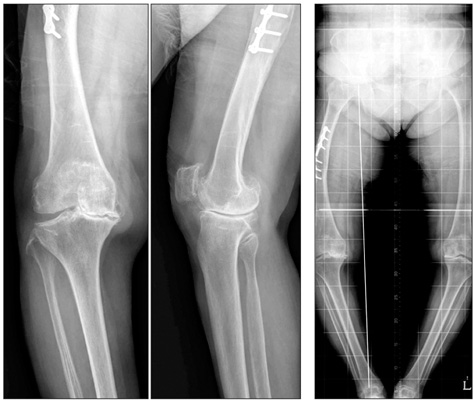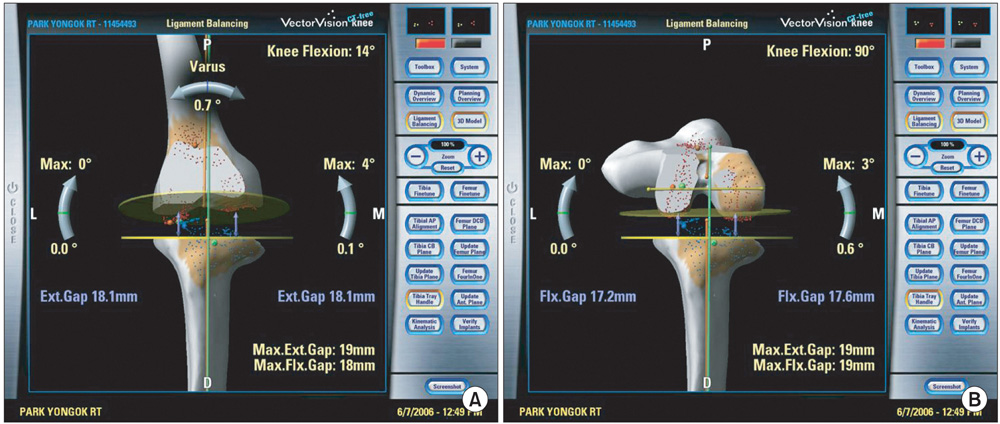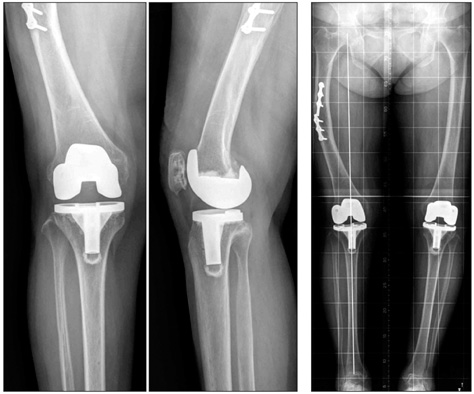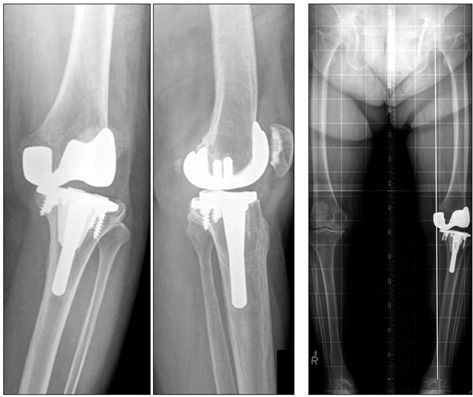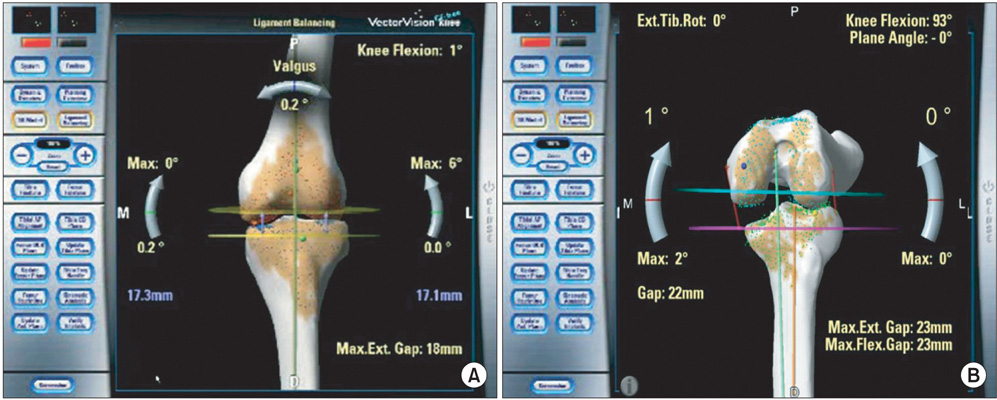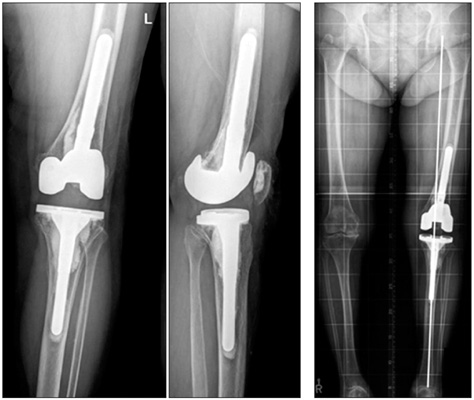Clin Orthop Surg.
2011 Dec;3(4):259-267. 10.4055/cios.2011.3.4.259.
Computer Assisted Navigation in Knee Arthroplasty
- Affiliations
-
- 1Department of Orthopaedic Surgery, Kyung Hee University School of Medicine, Seoul, Korea. songsjun@khmc.or.kr
- KMID: 1097162
- DOI: http://doi.org/10.4055/cios.2011.3.4.259
Abstract
- Computer assisted surgery (CAS) was used to improve the positioning of implants during total knee arthroplasty (TKA). Most studies have reported that computer assisted navigation reduced the outliers of alignment and component malpositioning. However, additional sophisticated studies are necessary to determine if the improvement of alignment will improve long-term clinical results and increase the survival rate of the implant. Knowledge of CAS-TKA technology and understanding the advantages and limitations of navigation are crucial to the successful application of the CAS technique in TKA. In this article, we review the components of navigation, classification of the system, surgical method, potential error, clinical results, advantages, and disadvantages.
Keyword
Figure
Cited by 2 articles
-
Computer-Assisted Navigation in High Tibial Osteotomy
Sang Jun Song, Dae Kyung Bae
Clin Orthop Surg. 2016;8(4):349-357. doi: 10.4055/cios.2016.8.4.349.Lateralization of Tibial Plateau Reference Point Improves Accuracy of Tibial Resection in Total Knee Arthroplasty in Patients with Proximal Tibia Vara
Rajshekhar K Thippana, Malhar N Kumar
Clin Orthop Surg. 2017;9(4):458-464. doi: 10.4055/cios.2017.9.4.458.
Reference
-
1. Merloz P, Tonetti J, Cinquin P, Lavallee S, Troccaz J, Pittet L. Computer-assisted surgery: automated screw placement in the vertebral pedicle. Chirurgie. 1998. 123(5):482–490.2. Krackow KA, Bayers-Thering M, Phillips MJ, Bayers-Thering M, Mihalko WM. A new technique for determining proper mechanical axis alignment during total knee arthroplasty: progress toward computer-assisted TKA. Orthopedics. 1999. 22(7):698–702.3. Friederich N, Verdonk R. The use of computer-assisted orthopedic surgery for total knee replacement in daily practice: a survey among ESSKA/SGO-SSO members. Knee Surg Sports Traumatol Arthrosc. 2008. 16(6):536–543.
Article4. Ritter MA, Faris PM, Keating EM, Meding JB. Postoperative alignment of total knee replacement: its effect on survival. Clin Orthop Relat Res. 1994. (299):153–156.
Article5. Mason JB, Fehring TK, Estok R, Banel D, Fahrbach K. Meta-analysis of alignment outcomes in computer-assisted total knee arthroplasty surgery. J Arthroplasty. 2007. 22(8):1097–1106.
Article6. Stulberg SD, Loan P, Sarin V. Computer-assisted navigation in total knee replacement: results of an initial experience in thirty-five patients. J Bone Joint Surg Am. 2002. 84:Suppl 2. 90–98.7. Anderson KC, Buehler KC, Markel DC. Computer assisted navigation in total knee arthroplasty: comparison with conventional methods. J Arthroplasty. 2005. 20:7 Suppl 3. 132–138.8. Catani F, Biasca N, Ensini A, et al. Alignment deviation between bone resection and final implant positioning in computer-navigated total knee arthroplasty. J Bone Joint Surg Am. 2008. 90(4):765–771.
Article9. Siston RA, Giori NJ, Goodman SB, Delp SL. Surgical navigation for total knee arthroplasty: a perspective. J Biomech. 2007. 40(4):728–735.
Article10. Pitto RP, Graydon AJ, Bradley L, Malak SF, Walker CG, Anderson IA. Accuracy of a computer-assisted navigation system for total knee replacement. J Bone Joint Surg Br. 2006. 88(5):601–605.
Article11. Graydon AJ, Malak S, Anderson IA, Pitto RP. Evaluation of accuracy of an electromagnetic computer-assisted navigation system in total knee arthroplasty. Int Orthop. 2009. 33(4):975–979.
Article12. Khadem R, Yeh CC, Sadeghi-Tehrani M, et al. Comparative tracking error analysis of five different optical tracking systems. Comput Aided Surg. 2000. 5(2):98–107.
Article13. Mihalko WM, Duquin T, Axelrod JR, Bayers-Thering M, Krackow KA. Effect of one- and two-pin reference anchoring systems on marker stability during total knee arthroplasty computer navigation. Comput Aided Surg. 2006. 11(2):93–98.
Article14. Jenny JY, Boeri C. Low reproducibility of the intra-operative measurement of the transepicondylar axis during total knee replacement. Acta Orthop Scand. 2004. 75(1):74–77.
Article15. Haaker RG, Stockheim M, Kamp M, Proff G, Breitenfelder J, Ottersbach A. Computer-assisted navigation increases precision of component placement in total knee arthroplasty. Clin Orthop Relat Res. 2005. (433):152–159.
Article16. Bathis H, Perlick L, Tingart M, Luring C, Zurakowski D, Grifka J. Alignment in total knee arthroplasty: a comparison of computer-assisted surgery with the conventional technique. J Bone Joint Surg Br. 2004. 86(5):682–687.17. Decking R, Markmann Y, Fuchs J, Puhl W, Scharf HP. Leg axis after computer-navigated total knee arthroplasty: a prospective randomized trial comparing computer-navigated and manual implantation. J Arthroplasty. 2005. 20(3):282–288.18. Bae DK, Yoon KH, Song SJ, Kim SG, Park KJ. Intraoperative versus postoperative measurement in total knee arthroplasty using computer-assisted orthopaedic surgery (CAOS): accuracy of CAOS. J Korean Orthop Assoc. 2005. 40(2):168–173.
Article19. Bae DK, Yoon KH, Song SJ, Kim SG, Im YJ, Kim MH. Comparative analysis of radiologic measurement according to TKR using computer assisted surgery and conventional TKR. J Korean Orthop Assoc. 2005. 40(4):398–402.
Article20. Stockl B, Nogler M, Rosiek R, Fischer M, Krismer M, Kessler O. Navigation improves accuracy of rotational alignment in total knee arthroplasty. Clin Orthop Relat Res. 2004. (426):180–186.21. Chauhan SK, Scott RG, Breidahl W, Beaver RJ. Computerassisted knee arthroplasty versus a conventional jig-based technique: a randomised, prospective trial. J Bone Joint Surg Br. 2004. 86(3):372–377.22. Siston RA, Patel JJ, Goodman SB, Delp SL, Giori NJ. The variability of femoral rotational alignment in total knee arthroplasty. J Bone Joint Surg Am. 2005. 87(10):2276–2280.
Article23. Siston RA, Goodman SB, Patel JJ, Delp SL, Giori NJ. The high variability of tibial rotational alignment in total knee arthroplasty. Clin Orthop Relat Res. 2006. 452:65–69.
Article24. Yau WP, Leung A, Chiu KY, Tang WM, Ng TP. Intraobserver errors in obtaining visually selected anatomic landmarks during registration process in nonimage-based navigation-assisted total knee arthroplasty: a cadaveric experiment. J Arthroplasty. 2005. 20(5):591–601.
Article25. Bauwens K, Matthes G, Wich M, et al. Navigated total knee replacement: a meta-analysis. J Bone Joint Surg Am. 2007. 89(2):261–269.26. Bae DK, Yoon KH, Kim SG, Park JW, Shin MC, Roh JH. Comparison of radiologic measurements of total knee replacement using computer-assisted navigation system and conventional system in varus deformity of the knee. J Korean Orthop Assoc. 2007. 42(2):227–235.
Article27. Longstaff LM, Sloan K, Stamp N, Scaddan M, Beaver R. Good alignment after total knee arthroplasty leads to faster rehabilitation and better function. J Arthroplasty. 2009. 24(4):570–578.
Article28. Molfetta L, Caldo D. Computer navigation versus conventional implantation for varus knee total arthroplasty: a case-control study at 5 years follow-up. Knee. 2008. 15(2):75–79.
Article29. Spencer JM, Chauhan SK, Sloan K, Taylor A, Beaver RJ. Computer navigation versus conventional total knee replacement: no difference in functional results at two years. J Bone Joint Surg Br. 2007. 89(4):477–480.30. Ishida K, Matsumoto T, Tsumura N, et al. Mid-term outcomes of computer-assisted total knee arthroplasty. Knee Surg Sports Traumatol Arthrosc. 2011. 19(7):1107–1112.
Article31. Kalairajah Y, Simpson D, Cossey AJ, Verrall GM, Spriggins AJ. Blood loss after total knee replacement: effects of computer-assisted surgery. J Bone Joint Surg Br. 2005. 87(11):1480–1482.32. Kim YH, Kim JS, Hong KS, Kim YJ, Kim JH. Prevalence of fat embolism after total knee arthroplasty performed with or without computer navigation. J Bone Joint Surg Am. 2008. 90(1):123–128.
Article33. Stulberg SD. Computer navigation as a teaching instrument in knee reconstruction surgery. J Knee Surg. 2007. 20(2):165–172.
Article34. Hart R, Janecek M, Chaker A, Bucek P. Total knee arthroplasty implanted with and without kinematic navigation. Int Orthop. 2003. 27(6):366–369.
Article35. Bae DK, Yoon KH, Kim SG, Park KJ. Efficacy of computer assisted surgery in revision total knee arthroplasty. J Korean Orthop Assoc. 2006. 41(6):974–980.
Article
- Full Text Links
- Actions
-
Cited
- CITED
-
- Close
- Share
- Similar articles
-
- Computer-Assisted Navigation in Total Knee Arthroplasty
- Total Knee Arthroplasty Using Computer-Assisted Navigation in Patient with Ipsilateral Hemiarthroplasty and Angle Blade Plate Fixation: A Case Report
- Navigation-Assisted Total Knee Arthroplasty for the Knee Retaining Femoral Intramedullary Nail, and Distal Femoral Plate and Screws
- Navigation-Assisted Knee Arthroplasty in Case of Extra-Articular Deformity or Retained Hardware
- Reliability and Validity of the Femorotibial Mechanical Axis Angle in Primary Total Knee Arthroplasty: Navigation versus Weight Bearing or Supine Whole Leg Radiographs

